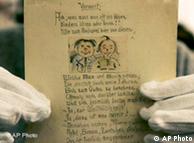“顽童捣蛋记”创造者威廉.布什去世百年
威廉.布什是德国一位家喻户晓的讽刺漫画家。一百年前的1月9日有“笑料大王”之称的这位漫画大师,在家乡下萨克森州与世长辞。威廉.布什最著名的漫画故事书“马克思和莫里茨”,中文译本的书名叫做“顽童捣蛋记”。
威廉.布什笔下的两名小坏蛋,数十年来为全球读者带来了无穷的乐趣。作者机智风趣的用语和词汇,往往成为后世的经典名句,例如:“作爸爸容易,但作一名称职的父亲很难”。出身下萨克森州穷乡僻壤的威廉.布什,是一名公认的怪人,围绕在他身边的一些谜团,至今无人破解。
德国19世纪的天才型人物-威廉.布什,于1832年的4月15日出生在汉诺威附近的一个小商贩家庭。他原先奉父母之命接受机械工人的培训教育,但 因兴趣不合而辍学。威廉想当画家,就报名进入杜塞尔多夫的艺术学院学习。但他对那儿的学习并不满意,于是转学到安普卫特,最后到了慕尼黑。1859年是威 廉转运的一年:他受到出版家及木刻家卡斯帕尔•布劳恩的提拔,为布劳恩出版的幽默讽刺周刊“飞翔的图片”,以及“慕尼黑连环图”杂志画插图。威廉.布什虽 然没有因此而成为画家,但却成了漫画家。而更重要的是,他发明了具连续性动作的“连环漫画”,漫画故事也由他亲自撰写。最近出版“威廉.布什传记”的女作 家魏斯维勒表示:“当时人们早已知道威廉.布什是个离群索居的孤僻怪人,但除此之外,他还患有严重的心理障碍,倒令人颇感意外。”
情绪沮丧的威廉.布什,以几近虐待狂般的想象力创造他的艺术作品。通过冷漠而尖锐的洞察力,他将庸俗狭隘的市侩小民作为漫画故事嘲讽的对象,如没家 教的野孩子、争吵打架的夫妻、醉醺醺的牧师、假正经的修女,或虐待动物者等等。他的漫画作品包罗了各种各样人类及动物的残暴死的亡方式:例如马克思和莫里 茨最后被磨坊碾碎;虔诚信教的海伦娜酒醉失手酿成火灾,对此,威廉布什写到:“废墟、瓦砾中仅存一缕青烟,其余全部付诸一炬。”。其他的漫画人物,有的被 炸死,有的被碾平,或被砍头,或被穿鼻孔吊死,其中部份具有反映时局的历史背景,当然大部份出自漫画家的个人手笔。威廉.布什专家魏斯维勒女士指出:“我 的看法是,如果读者从两名顽童恶整的角度来阅读‘顽童捣蛋记’的话,就完全误解了作者的本意。我们必须考虑到1860那个时代背景:当时的汉诺威王朝正经 历着日落西山的衰亡期,乡村爆发了恐怖的大饥荒。居民因所得低到无法生存而成群地饿死。流离失所的孤儿们,成群结队组成了帮派,他们除了抢劫偷窃已走投无 路,其中许多孩子还成了通缉犯。马克思和莫里茨是这帮流浪儿的代表性人物:他们无父无母,连死去也没人为他们伤心落泪。漫画书封面上的马克思和莫里茨,看 上去像极了通缉犯的画像。其实这本漫画故事书是针对社会乱象的严厉控诉,说白了,就是对那些贪婪自私的市侩小人提出的指控。”
特立独行的威廉.布什日常生活主要是坐在画架及书桌前度过的。他整天烟不离手,喜欢纵酒狂饮,还养了一群蜜蜂。据说,曾有一名女性在他的生命中起到 过影响,她是银行家克斯勒的夫人约翰娜。1868年,约翰娜在她法兰克福的住宅里,为威廉布.什安置了住处和一间工作室。1877年两人关系破裂,威廉. 布什回到老家下萨克森定居,过着富裕生活,直到安祥地离开人世。
Max and Moritz
世界文学小经典--顽童捣蛋记Max and Moritz
绿原 译
湖北少儿 2003年08月 出版
关于本书
每个德国人都知道马克斯和摩里茨。即使咋力“出口货”来说。这两个标雄的小坏蛋也可说是“有口皆碑”。但是,须知正是通过这本书,他们才 得以共襄联络各民族的盛举?不论是德语原文,还是相应的美,法、西、意和拉丁语译本,又都靠这些图画得以流传。哪怕只对其中某一种语言略有了解的读者,读 起本书来,都会读得开怀大笑。至于每个熟悉多种语言的人,他就越发会在这里找到富有文化气的娱乐和饶有趣味的教益。关于作者威廉·布什(Wilhelm Busch,1832—1908)的名字,在德国同样是家喻户晓。除了本书,他还写过其它许多连环漫画故事诗,在这一点上,可称得上德国的“笑料大王”。 虽然,他也写过一些比较严肃的诗作,以机智亲切包装其中的怀疑,以喜悦包装其中的忧郁,但这些诗作并不像本书这样著名。威廉·布什作为画家,更是受到大家 的赏识,本书的插图闻名遐迩,就是证明。在《马克斯和摩里茨Max and Moritz》(1865)之外,他的连环漫画故事诗还有《帕度雅的圣安东》(1870),《虔敬的海伦》 (1872),《伴腔》(1874),《克诺普夫妇》(1876),《猴子打榧子》(1879),《普利施和普鲁姆》(1882)等。
关于中译本
《马克斯和摩里茨》的中译本,改名为《顽童捣蛋记》,是译者1989年应德国汉诺威市威廉·布什博物馆为该书出版125周年纪念所约而译的。这个中译本曾被收入同年该馆所编大型威廉·布什纪念册中,其中除德语、英语等文本外,新增瓦龙语(比利时南部罗马化日耳曼人后裔所用方言)、葡萄牙语、日语、俄语和汉语等 文本。原文采用德语口语,中译本相应试图口语化。是否有当,还请广大读者指教。
译 者
(b Wiedensahl, 15 April 1832; d Mechtshausen, 9 Jan 1908). German draughtsman, painter and writer. A grocer's son and the first of seven children, he enrolled at the Polytechnische Schule in Hannover to train (1847-51) as an engineer but, while there, decided to become an artist. In 1851 he transferred to the Akademie in Düsseldorf where he remained for a year, attending elementary classes in life drawing with Carl Ferdinand Sohn and studying proportion and anatomy with Heinrich Anton Mücke (1806-91). In May 1852 he moved to the less severely doctrinaire Academy in Antwerp, but the obsessive concern for precision of his tutor, the genre painter Joseph-Laurent Dyckmans (1811-88), did not appeal to him. As he conceded in 1886 in his autobiography, Was mich betrifft, he was assailed by doubts about his talent as a painter, not because of the demands of an academic training but because of the apparently unsurpassable example of Frans Hals and other Old Masters whose works he had studied in the Koninklijk Museum in Antwerp. During this period Busch produced several studies of heads in oils on cardboard that were freer in execution than his work in Düsseldorf, for example Portrait of a Young Man (c. 1852; Hannover, Wilhelm-Busch-Mus.), as well as drawings of views of Antwerp. In May 1853, after an attack of typhoid, he returned home to Wiedensahl, where he lived for the next 18 months, collecting legends and fairy tales of the Weser region and making drawings of gravestones and antiques in the area for a scholar in Berlin. He also painted oil studies of peasants in Bückeburg and portraits of members of his family, for example Domestic Studies: Otto Busch Reading (c. 1854; Hannover, Wilhelm-Busch-Mus.).
See the Abbreviations for further details.
Busch, Wilhelm (1832–1908), German writer, painter, and poet, who is internationally famous for his Max and Moritz (1865) illustrated stories in verse that served as a model for the American comic strip ‘The Katzenjammer Kids’, which originated in 1897.
Busch created other books for children that depicted their comic antics and can be considered forerunners to the 20th‐century cartoon. Early in his career, from 1859 to 1871, he participated in creating many of the humorous broadsheets for the Münchner Bilderbogen.
One of his earliest, not included in the Münchner Bilderbogen, was a farcical portrayal of ‘Hansel and Gretel’, printed in Bilderpossen (Farcical Pictures, 1864). Given his sceptical if not pessimistic outlook on life, in part due to the influence of Schopenhauer, Busch was not drawn to the optimistic fairy tale, unless he could sarcastically criticize it and re‐design it to make some biting social commentary. His best work along these lines was his illustrated book
Sechs Geschichten für Neffen und Nichten (Six Stories for Nephews and Nieces, 1881). These hilarious tales, told in verse, with simple coloured ink drawings, turn the traditional tales upside down. An example is ‘Die beiden Schwestern’ (‘The Two Sisters’), which is a parody of both ‘The Frog King’ and ‘Mother
One day Kätchen goes into the woods and meets a frog who cries out, ‘Pity me and give me a kiss.’ In fact, she gives him three kisses, and he turns into a prince, rewarding her with wealth and marriage. Then Adelheid goes dressed to kill into the woods and meets a prince playing a harp next to a pond. When he asks for a kiss, she consents, but he turns into a water imp and drags her into the pond, where she must spend her life serving him. The tongue‐in‐cheek ending is typical of most Busch stories that, similar to Heinrich Hoffmann's Struwwelpeter, take delight in provocative cruel punishments.
Bibliography
- Bohne, F., Wilhelm Busch (1958).
- Ehrlich, J., Wilhelm Busch, der Pessimist (1962).
— Jack Zipes



沒有留言:
張貼留言